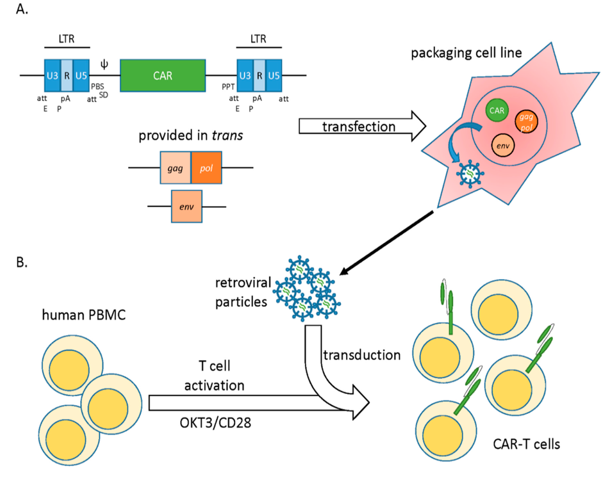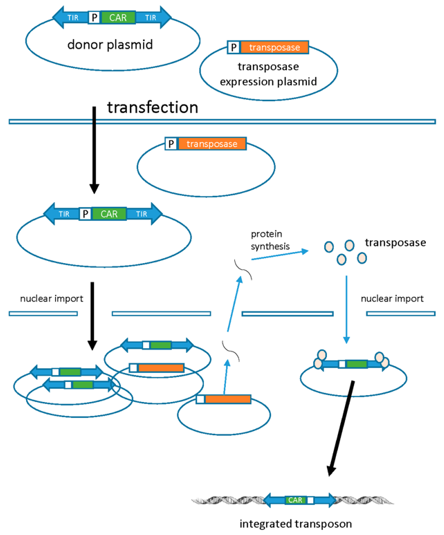Chimeric antigen receptor (CAR) T‐cell therapy is a new successful treatment for refractory B‐cell leukemia. After isolating T cells, the expanded T cells are purified and then transduced with a gene encoding the engineered CAR via a retroviral vector, typically Gammaretroviral vectors and Lentiviral vectors. These vectors are very safe in modern times due to a partial deletion of the U3 region.

The methods include three viral vector gene transfer technologies (alpha-retrovirus, gamma-retrovirus, and lentivirus), transposons, and mRNA electroporation. Each system has their advantages and drawbacks with an emphasis on achieving durable transgene expression in the absence of clinical safety concerns.
Gamma Retroviral Vectors
Gamma retroviral vectors have been efficiently used to express chimeric antigen receptors (CARs) in T lymphocytes. Typically, peripheral blood mononuclear cells (PBMCs) from patients are stimulated with anti-CD3 and anti-CD28 monoclonal antibodies (MAb) along with exogenous IL-2 to select and expand T cells within peripheral blood lymphocytes (PBLs).
Lentiviral Vectors
Lentivirus-based vectors are structurally similar to their gamma retroviral counterparts, wherein the essential viral genes are replaced with a transgene of interest, and the viral genome is stably integrated into the host cell. In addition to gag, pol, and env, lentivirus-based vectors require the trans presentation of the rev gene.
Transposons
DNA transposons are a non-viral alternative for stable gene transfer. In nature, transposons are discrete pieces of DNA containing the transposase gene flanked by terminal inverted repeats (TIRs) that contain the transposase binding sites. Transposon-based vector systems like the Sleeping Beauty (SB) system are built to utilize transposition as a way to introduce a transgene of interest into the host genome.

mRNA Electroporation
Messenger RNA (mRNA) transfer-mediated gene expression has been gaining popularity as a safer alternative to viral and plasmid DNA (pDNA)-based approaches. mRNA transfer represents a cytoplasmic expression system, i.e., it does not need to enter the nucleus to mediate its function.
Each of the T cell gene engineering techniques has its advantages and disadvantages. Given the rapid progress of the field it is certain that the T cell gene transfer methods described here will continue to advance and lead to more effective treatments for cancer.
BioCytoceuticals is an experienced and outstanding provider of CAR gene package service. Our scientists are pleased to use extensive experience and advanced platform to offer the best service to satisfy each demand from our customers.
If you have any special need in CAR gene package service, do not hesitate to contact us for this special service. Please let us know what you need and we will accommodate you. We are looking forward to working with you in the future.
Inquiry